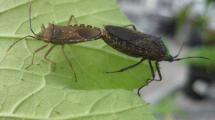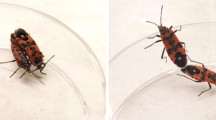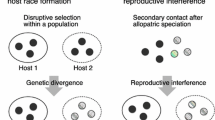Abstract
In the context of animal behaviour, a harem is generally recognised as a mating system where a single dominant male defends and mates with a group of females. Examples of harem polygyny are best known from mammals. A small number of insects, though, have been described as being harem polygynous but information on insects which display this mating system is scarce, and it remains poorly studied. Here we review the mating systems of these “harem polygynous” insects. We identify four main behavioural characteristics that, apart from individual males mating with multiple females in a group, are often associated with harem polygyny in vertebrates: exclusive maternal care, monandry, male-biased sexual dimorphism and temporal continuity of harem composition where the dominant male guards females from intruding males over a prolonged period. All four characteristics are commonly seen in mammals with this mating system, but no insect described as harem polygynous consistently displays all of them. Further, the mating systems of these insects can change within a breeding season, which suggests that they adapt to the changes in their environment by switching between polygyny and monogamy or female defence and resource defence polygyny. Thus, the occasional occurrence of harems in such insect species represents temporary “marriages of convenience”—with individuals (male and female) maximising their reproductive potential by adjusting their behaviour to fit the current situation.
Similar content being viewed by others
References
Alcock J (1980) Natural selection and the mating systems of solitary bees. Am Sci 68:146–153
Aluja M, Lozada N, Piñero J, Birke A, Hernández-Ortiz V, Díaz-Fleischer F (2001) Basic behavior of Rhagoletis turpiniae (Diptera: Tephritidae) with comparative notes on the sexual behavior of Rhagoletis pomonella and Rhagoletis zoqui. Ann Entomol Soc Am 94:268–274
Anderbrant O, Löfqvist J (1988) Relation between first and second brood production in the bark beetle Ips typographus (Scolytidae). Oikos 53:357–365
Apollonio M, Festa-Bianchet M, Mainardi D (eds) (2000) Vertebrate mating systems. World Scientific Publ, Singapore
Arnqvist G, Nilsson T (2000) The evolution of polyandry: multiple mating and female fitness in insects. Anim Behav 60:145–164
Asa CS (1999) Male reproductive success in free-ranging feral horses. Behav Ecol Sociobiol 47:89–93
Bartos L, Bahbouh R (2006) Antler size and fluctuating asymmetry in red deer (Cervus elaphus) stags and probability of becoming a harem holder in rut. Biol J Linn Soc 87:59–68
Bonenfant C, Gaillard J, Klein F, Maillard D (2004) Variation in harem size of red deer (Cervus elaphus L.): the effects of adult sex ratio and age-structure. J Zool 264:77–85
Borgia G (1980) Sexual competition in Scatophaga stercoraria: size- and density- related changes in male ability to capture females. Behaviour 75:185–206
Buzzatto BA, Machado G (2008) Resource defense polygyny shifts to female defense over the course of the reproductive season of a Neotropical harvestman. Behav Ecol Sociobiol 63:85–94
Campagna C, Lewis M, Baldi R (1993) Breeding biology of southern elephant seals in Patagonia. Mar Mammal Sci 9:34–47
Carey M, Nolan V Jr (1975) Polygyny in indigo buntings: a hypothesis tested. Science 190:1296–1297
Carothers JH (1981) Dominance and competition in an herbivorous lizard. Behav Ecol Sociobiol 8(4):261-266
Carranza J (1995) Female attraction by males versus sites in territorial rutting red deer. Anim Behav 50:445–453
Cassini MH (1999) The evolution of reproductive systems in pinnipeds. Behav Ecol 10:612–616
Choe JC (1994) Sexual selection and mating system in Zorotypus gurneyi Choe (insects: Zoraptera): I. Dominance hierarchy and mating success. Behav Ecol Sociobiol 34:87–93
Clutton-Brock TH (1989) Review lecture: mammalian mating systems. Proc R Soc Lond Ser B Biol Sci 236:339–372
Clutton-Brock TH, Harvey PH (1978) Mammals, resources and reproductive strategies. Nature 273:191–195
Clutton-Brock TH, Vincent AC (1991) Sexual selection and the potential reproductive rates of males and females. Nature 351:58–60
Clutton-Brock TH, Albon SD, Gibson RM, Guinness FE (1979) The logical stag: adaptive aspects of fighting in red deer (Cervus elaphus L.). Anim Behav 27:211–225
Cotton AJ, Cotton S, Small J, Pomiankowski A (2015) Male mate preference for female eyespan and fecundity in the stalk-eyed fly, Teleopsis dalmanni. Behav Ecol 26:376–385
Cowles SA, Gibson RM (2015) Displaying to females may lower male foraging time and vigilance in a lekking bird. Auk 132:82–91
De Ridder E, Pinxten R, Eens M (2000) Experimental evidence of a testosterone-induced shift from paternal to mating behaviour in a facultatively polygynous songbird. Behav Ecol Sociobiol 49:24–30
Dechmann DKN, Kalko EKV, Konig B, Kerth G (2005) Mating system of a neotropical roost-making bat: the white-throated, round-eared bat, Lophostoma silvicolum (Chiroptera: Phyllostomidae). Behav Ecol Sociobiol 58:316–325
Emlen ST, Oring LW (1977) Ecology, sexual selection, and the evolution of mating systems. Science 197:215–223
Fischhoff IR, Dushoff J, Sundaresan SR, Cordingley JE, Rubenstein DI (2009) Reproductive status influences group size and persistence of bonds in male plains zebra (Equus burchelli). Behav Ecol Sociobiol 63:1035–1043
Fox CW, Czesak ME (2000) Evolutionary ecology of progeny size in arthropods. Annu Rev Entomol 45:341–369
Franklin W (1974) The social behaviour of the vicuña. In: Geist V, Walther F (eds) The behaviour of ungulates and its relation to management. IUCN Publications, Morgues, pp 477–487
Fujisaki K (1981) Studies on the mating system of the winter cherry bug, Acanthocoris sordidus Thunberg (Heteroptera: Coreidae) II. Harem defence polygyny. Res Popul Ecol (Kyoto) 23:262–279
Galimberti F, Boitani L, Marzetti I (2000) The frequency and costs of harassment in southern elephant seals. Ethol Ecol Evol 12:345–365
Gerell R, Lundberg K (1985) Social organization in the bat Pipistrellus pipistrellus. Behav Ecol Sociobiol 16:177–184
Gibbs GW (2001) Habitats and biogeography of New Zealand’s deinacridine and tusked weta species. In: Field LH (ed) The biology of wetas, king crickets and their allies. CAB International Publishing, Wallingford, pp 35–55
Gilbert JDJ, Thomas LK, Manica A (2010) Quantifying the benefits and costs of parental care in assassin bugs. Ecol Entomol 35:639–651
Göransson G, von Schantz T, Fröberg I, Helgee A, Wittzell H (1990) Male characteristics, viability and harem size in the pheasant, Phasianus colchicus. Anim Behav 40:89–104
Gosling LM (1986) The evolution of mating strategies in male antelopes. In: Rubenstein DI, Wrangham RW (eds) Ecological aspects of social evolution: birds and mammals. Princeton University Press, Princeton, pp 244–281
Groddeck J, Mauss V, Reinhold K (2004) The resource-based mating system of the Mediterranean pollen wasp Ceramius fonscolombei Latreille 1810 (Hymenoptera, Vespidae, Masarinae). J Insect Behav 17:397–418
Guinness F, Lincoln GA, Short RV (1971) The reproductive cycle of the female red deer, Cervus elaphus L. J Reprod Fertil 27:427–438
Gwynne DT (1980) Female defence polygyny in the bumblebee wolf, Philanthus bicinctus (Hymenoptera: Sphecidae). Behav Ecol Sociobiol 7:213–225. https://doi.org/10.1007/BF00299367
Gwynne DT, Jamieson I (1998) Sexual selection and sexual dimorphism in a harem-polygynous insect, the alpine weta (Hemideina maori, Orthoptera Stenopelmatidae). Ethol Ecol Evol 10:393–402
Herberstein ME, Painting CJ, Holwell GI (2017) Scramble competition polygyny in terrestrial arthropods. Adv Study Behav 49:237–295
Hoglund J, Alatalo RV (1995) Leks. Princeton University Press, Princeton
Hoi-Leitner M, Hoi H, Romero-Pujante M, Valera F (1999) Female extra-pair behaviour and environmental quality in the serin (Serinus serinus): a test of the ‘constrained female hypothesis’. Proc R Soc Lond B 266:1021–1026
Iyengar VK, Starks BD (2008) Sexual selection in harems: male competition plays a larger role than female choice in an amphipod. Behav Ecol 19:642–649
Kelly CD (2006a) Movement patterns and gallery use by the sexually dimorphic Wellington tree weta. N Z J Ecol 30:273–278
Kelly CD (2006b) Resource quality or harem size: what influences male tenure at refuge sites in tree weta (Orthoptera: Anostostomatidae)? Behav Ecol Sociobiol 60:175–183
Kelly CD (2008) Why do male tree weta aggressively evict females from galleries after mating? Ethology 114:203–208
Kernaléguen L, Cherel Y, Guinet Y, Arnould JPY (2016) Mating success and body condition not related to foraging specializations in male fur seals. R Soc Open Sci 3:3. https://doi.org/10.1098/rsos.160143
Kirkendall LR (1983) The evolution of mating systems in bark and ambrosia beetles (Coleoptera: Scolytidae and Platypodidae). Zool J Linnean Soc 77:293–352
Kirkendall LR, Biedermann PHW, Jordal BH (2015) Evolution and diversity of bark and ambrosia beetles. In: Vega FE, Hofstetter RW (eds) Bark beetles: biology and ecology of native and invasive species. Academic Press, San Diego, pp 85–156
Kleiman DG, Malcolm JR (1981) The evolution of male parental investment in mammals. In: Gubernick DJ, Klopfer PH (eds) Parental care in mammals. Plenum Press, New York, pp 347–390
Klingel H (1974) A comparison of the social behaviour of the Equidae. In: Geist V, Walther F (eds) The behaviour of ungulates and its relation to management. IUCN Publication, Morgues, pp 124–132
Kodric-Brown A, Brown JH (1984) Truth in advertising: the kinds of traits favored by sexual selection. Am Nat 124:309–323
Kokko H, Jennions MD (2008) Parental investment, sexual selection and sex ratios. J Evol Biol 21:919–948
Kokko H, Jennions MD (2012) Sex differences in parental care. In: Kolliker M, Smiseth PT, Royle NJ (eds) The evolution of parental care. OUP Oxford, Oxford, pp 101–116
Kwiatkowski MA, Sullivan BK (2002) Mating system structure and population density in a polygynous lizard, Sauromalus obesus (=ater). Behav Ecol 13:201–208
Langbein J, Thirgood SJ (1989) Variation in mating systems of fallow deer (Dama dama) in relation to ecology. Ethology 83:195–214
Lanier GN, Cameron EA (1969) Secondary sexual characters in the North American species of the genus Ips (Coleoptera: Scolytidae). Can Entomol 101:862–870
Latty TM, Magrath MJL, Symonds MRE (2009) Harem size and oviposition behaviour in a polygynous bark beetle. Ecol Entomol 34:562–568
Le Boeuf BJ (1974) Male-male competition and reproductive success in elephant seals. Am Zool 14:163–176
M’Closkey RT, Deslippe RJ, Szpak CP (1990) Tree lizard distribution and mating system: the influence of habitat and food resources. Can J Zool 68:2083–2089
Machado G, Trumbo ST (2018) Parental care. In: Cordobe-Aguilar A, Gonzalez-Tokman D, Gonzales-Santoyo I (eds) Insect behavior: From mechanisms to ecological and evolutionary consequences. Oxford University Press, Oxford, pp 203–218
Mayr E (1939) The sex ratio in wild birds. Am Nat 73:156–179
McCann TS, Fedak MA, Harwood J (1989) Parental investment in southern elephant seals, Mirounga leonina. Behav Ecol Sociobiol 25:81–87
Mitchell PL (1980) Combat and territorial defense of Acanthocephala femorata (Hemiptera: Coreidae). Ann Entomol Soc Am 73:404–408
Miyatake T (2002) Multi-male mating aggregation in Notobitus meleagris (Hemiptera: Coreidae). Ann Entomol Soc Am 95:340–344
Moller H (1985) Tree wetas (Hemideina crassicruris) (Orthoptera: Stenopelmatidae) of Stephens Island, Cook Strait. N Z J Zool 12:55–69
Moller AP, Thornhill R (1998) Male parental care, differential parental investment by females and sexual selection. Anim Behav 55:1507–1515
Morgan-Richards M, Gibbs GW (2001) A phylogenetic analysis of New Zealand giant and tree weta (Orthoptera: Anostostomatidae: Deinacrida and Hemideina) using morphological and genetic characters. Invertebr Taxon 15:1–12
Mouton PFN, van Wyk JH (1993) Sexual dimorphism in cordylid lizards: a case study of the Drakensberg crag lizard, Pseudocordylus melanotus. Can J Zool 71:1715–1723
Nolen ZJ, Allen PE, Miller CW (2017) Seasonal resource value and male size influence male aggressive interactions in the leaf footed cactus bug, Narnia femorata. Behav Process 138:1–6
Ohba S, Matsuo S, Huynh TTT, Kudo S (2018) Female mate preference for egg-caring males in the giant water bug Diplonychus rusticus (Heteroptera Belostomatidae). Ethol Ecol Evol 30:477–484. https://doi.org/10.1080/03949370.2018.1438517
Ordish RG (1992) Aggregation and communication of the wellington weta Hemideina crassidens (Blanchard) (Orthoptera: Stenopelmatidae). N Z Entomol 15:1–8
Orians GH (1969) On the evolution of mating systems in birds and mammals. Am Nat 103:589–603
Ortega J, Arita HT (2002) Subordinate males in harem groups of Jamaican fruit-eating bats (Artibeus jamaicensis): satellites or sneaks? Ethology 108:1077–1613
Ostfeld RS (1987) On the distinction between female defense and resource defense polygyny. Oikos 48:238–240
Parnell RJ (2002) Group size and structure in western lowland gorillas (Gorilla gorilla gorilla) at Mbeli Bai, Republic of Congo. Am J Primatol 56:193–206
Polak M (2006) Booming activity of male bitterns Botaurus stellaris in relation to reproductive cycle and harem size. Ornis Fenn 83:27–33
Prager SM, Richardson JML (2012) An ecological analysis of mating biology of Xylocopa virginica in southern Ontario. Ecol Entomol 37:283–292
Preston BT, Steveson IR, Permberton JM, Coltman DW, Wilson K (2003) Overt and covert competition in a promiscuous mammal: the importance of weaponry and testes size to male reproductive success. Proc R Soc Lond B 270:633–640
Pruett-Jones SG, Pruett-Jones MA (1990) Sexual selection through female choice in Lawes’ parotia, a lek-mating bird of paradise. Evolution 44:486–501
Rowell TE (1987) On the significance of the concept of the harem when applied to animals. Soc Sci Inf 23:649–669
Schlyter F, Zhang Q-H (1996) Testing avian polygyny hypotheses in insects: harem size distribution and female egg gallery spacing in three Ips bark beetles. Oikos 76:57–69
Shuster SM, Wade MJ (2003) Mating systems and strategies. Princeton University Press
Simmons LW (2005) The evolution of polyandry: sperm competition, sperm selection, and offspring viability. Annu Rev Ecol Evol Syst 36:125–171
Small J, Cotton S, Fowler K, Pomiankowski A (2009) Male eyespan and resource ownership affect contest outcome in the stalk-eyed fly, Teleopsis dalmanni. Anim Behav 78:1213–1220
Sommer V, Rajpurohit LS (1989) Male reproductive success in harem troops of Hanuman langurs (Presbytis entellus). Int J Primatol 10:293–317
Stillwell RC, Blanckenhorn WU, Teder T, Davidowitz G, Fox CW (2010) Sex differences in phenotypic plasticity affect variation in sexual size dimorphism in insects: from physiology to evolution. Annu Rev Entomol 55:227–245
Stopher KV, Nussey DH, Clutton-Brock TH, Guinness F, Morris A, Pemberton JM (2011) The red deer rut revisited: female excursions but no evidence females move to mate with preferred males. Behav Ecol 22:808–818
Temrin H, Sillen-Tullberg B (1994) The evolution of avian mating systems: a phylogenetic analysis of male and female polygamy and length of pair bond. Biol J Linn Soc 52:121–149
Thornhill R, Alcock J (1983) The evolution of insect mating systems. Massachusetts Harvard Univ Press, Cambridge
Tinkle DW (1969) The concept of reproductive effort and its relationship to the evolution of life histories of lizards. Am Nat 103:501–516
Tong W, Shapiro B, Rubenstein DI (2015) Genetic relatedness in two-tiered plains zebra societies suggests that females choose to associate with kin. Behav 152: 2059-2078
Trivers RL (1972) Parental investment and sexual selection. In: Campbell B (ed) Sexual selection and the descent of man, 1871–1971. Aldine Publishing Company, Chicago, pp 136–179
Verner J (1964) Evolution of polygamy in the long-billed marsh wren. Evolution 18:252–261
Vila BL, Cassini MH (1994) Time allocation during the reproductive season in vicunas. Ethology 97:226–235
Wagner TL, Flamm RO, Hennier PB, Wu W, Coulson RN (1988) A temperature-dependent model of reemergence of Ips avulsus (Coleoptera: Scolytidae). Environ Entomol 17:192–198
Wawrzyk AC (2013) Saberes etozoológicos de los pastores andinos: su importancia para la conservación y manejo de la vicuña (Vicugna vicugna). Ecol Austral 23:156–164
Wehi PM, Jorgensen M, Morgan-Richards M (2013) Sex- and season-dependent behaviour in a flightless insect, the Auckland tree weta (Hemideina thoracica). N Z J Ecol 37:75–83
Weissmann MJ (1997) Natural history of the giant sand treader camel cricket, Daihinibaenetes giganteus Tinkham (Orthoptera: Rhaphidophoridae). J Orthop Res 6:33–48
Wood SL (1982) The bark and ambrosia beetles of North and Central America (Coleoptera: Scolytidae), a taxonomic monograph. Gt Basin Nat Mem 6:1–1326
Ziadi-Künzli F, Tachinara K (2016) Female defence polygyny and plasticity in the mating system of the demersal triggerfish Rhinecanthus aculeatus (Pisces: Balistidae) from Okinawa Island. Mar Biol 163:27. https://doi.org/10.1007/s00227-015-2780-z
Acknowledgements
MJG is supported by Deakin University Postgraduate Research Scholarship. We thank Glauco Machado and a second anonymous reviewer for the valuable comments on the manuscript.
Author information
Authors and Affiliations
Corresponding author
Ethics declarations
Conflict of interest
The authors declare that they have no conflict of interest.
Additional information
Communicated by J. C. Choe
Publisher’s Note
Springer Nature remains neutral with regard to jurisdictional claims in published maps and institutional affiliations.
Rights and permissions
About this article
Cite this article
Griffin, M.J., Holwell, G.I. & Symonds, M.R.E. Insect harem polygyny: when is a harem not a harem?. Behav Ecol Sociobiol 73, 40 (2019). https://doi.org/10.1007/s00265-019-2652-5
Received:
Revised:
Accepted:
Published:
DOI: https://doi.org/10.1007/s00265-019-2652-5




